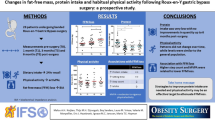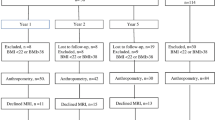Abstract
Background
Weight regain 24 months after Roux-en-Y gastric bypass (RYGB) and low protein intake in patients without protein supplementation can favor fat-free mass loss and reduce resting energy expenditure (REE). We aimed to assess REE and its association with the body composition of women with weight regain and no protein supplementation in the late postoperative period of RYGB.
Methods
We determined the body mass index (BMI), REE by indirect calorimetry, body composition by tetrapolar bioelectrical impedance analysis, and energy intake by two 24-h recalls of 34 patients with at least 5 % of weight regain and no protein supplementation. The software SPSS v.17 analyzed the data calculating measures of central tendency and dispersion and using Pearson’s correlation to test the association between the variables and the multivariate linear regression model at a p < 0.05 significance level.
Results
Postoperative period was positively associated with weight regain (r = 0.39; p = 0.023). The mean percentages of fat and fat-free masses were 45.1 ± 8.3 % and 54.3 ± 8.1 %, respectively. The mean REE was 1424.7 ± 187.2 kcal (14 kcal/kg of the current weight), mean energy intake was 1258.6 ± 454.3 kcal, and mean protein intake was 0.9 g/kg of the ideal weight ± 0.3. Fat-free mass was positively associated with REE regardless of protein intake and postoperative period.
Conclusions
Female bariatric patients with weight regain and no protein supplementation lose fat-free mass, lowering their REE. Health practices that promote maintenance of BMI and body composition may lead to improved outcomes of bariatric surgery.
Similar content being viewed by others
Abbreviations
- 24HR:
-
24-h recalls
- AACE/TOS/ASMBS:
-
American Association of Clinical Endocrinologists/The Obesity Society/American Society for Metabolic & Bariatric surgery
- BF:
-
Body fat
- BMI:
-
Body mass index
- FFM:
-
Fat-free mass
- REE:
-
Resting energy expenditure
- RYGB:
-
Roux-en-Y gastric bypass
References
Carey DG, Pliego GJ, Raymond RL. Body composition and metabolic changes following bariatric surgery: effects on fat mass, lean mass and basal metabolic rate. Obes Surg. 2006;16:469–77.
Carrasco F, Papapietro K, Csendes A, et al. Changes in resting energy expenditure and body composition after weight loss following Roux-en- Y gastric bypass. Obes Surg. 2007;17:608–16.
Magro DO, Geloneze B, Delfini R, et al. Long-term weight regain after gastric bypass: a 5-year prospective study. Obes Surg. 2008;18:648–51.
Prevedello CF, Colpo E, Mayer ET, et al. Análise do impacto da cirurgia bariátrica em uma população do centro do estado do Rio Grande do Sul utilizando o método BAROS. Arq Gastroenterol. 2009;46(3):199–203.
Faria SL, Faria OP, Buffington C, et al. Energy expenditure before and after Roux-en-Y gastric bypass. Obes Surg. 2012;22(9):1450–5.
Das SK, Roberts SB, Mccrory MA, et al. Long-term changes in energy expenditure and body composition after massive weight loss induced by gastric bypass surgery. Am J Clin Nutr. 2003;78:22–30.
Pasiakos SM, Cao JJ, Margolis LM, et al. Effects of high-protein diets on fat-free mass and muscle protein synthesis following weight loss: a randomized controlled trial. FASEB J. 2013;27(9):3837–47.
Moizé V, Andreu A, Rodríguez L, et al. Protein intake and lean tissue mass retention following bariatric surgery. Clin Nutr. 2012;32(4):550–5.
Mechanick JI, Youdim A, Jones DB, Garvey T, Hurley DL, McMahon MM, et al. Clinical practice guidelines for the perioperative nutritional, metabolic, and nonsurgical support of the bariatric surgery patient – 2013 update: cosponsored by American Association of Clinical Endocrinologists, The Obesity Society, and American Society for Metabolic & Bariatric surgery (AACE/TOS/ASMBS Guidelines). Endocr Pract. 2013;19(2):337–72.
Apovian, CM, Aronne, LJ, Bessesen, DH, et al. Pharmacological management of obesity: an endocrine society clinical practice guideline. J Clin Endocrinol Metab. 2015;100(2):342–362.
WHO (World Health Organization). Physical status: the use and interpretation of anthropometry. (Technical Report Series, 854). Genebra: OMS; 1995.
Kyle UG, Bosaeus I, De Lorenzo AD, et al. Bioelectrical impedance analysis – part II: utilization in clinical practice. Clin Nutr. 2004;23:1430–53.
Kamimura MA, Avesani CM, Draibe SA, et al. Gasto Energético de Repouso em pacientes com doença renal crônica. Rev Nutr. 2008;21(1):75–84.
WHO. World Health Organization. Summary: surveillance of risk factors for non communicable diseases. The WHO STEP wise approach. Geneva: WHO; 2001.
Sjostrom L, Lindroos A, Peltonen A. Lifestyle, diabetes, and cardiovascular risk factors 10 years after bariatric surgery. N Engl J Med. 2004;351(6):2683–93.
Barham K, Dayyeh A, Lautz DB, et al. Gastrojejunal stoma diameter predicts weight regain after roux-en-y gastric bypass. Clin Gastroenterol Hepatol. 2011;9:228–33.
Aquino LA, Pereira SE, Silva JS, et al. Bariatric surgery: impact on body composition after Roux-en-Y gastric bypass. Obes Surg. 2012;22(2):195–200.
Stiegler P, Cunliffe A. The role of diet and exercise for the maintenance of fat-free mass and resting metabolic rate during weight loss. Sports Med. 2006;36(3):239–62.
Heber D, Greenway FL, Kaplan LM, et al. Endocrine and nutritional management of the post-bariatric surgery patient: an OBES SURG Endocrine Society Clinical Practice Guideline. J Clin Endocrinol Metab. 2010;95(11):4823–43.
Stegen S, Derave W, Calders P, et al. Physical fitness in morbidly obese patients: effect of gastric bypass surgery and exercise training. Obes Surg. 2011;21:61–70.
Residori L, Garcia-Lorda P, Flancbaum L, et al. Prevalence of comorbidities in obese patients before bariatric surgery: effect of race. Obes Surg. 2003;13:333–40.
Gomes AA, Leão LSCS. Prevalência de sub-relato e super-relato de ingestão energética em população ambulatorial do Rio de Janeiro, Brasil. Cad Saúde Colet. 2011;2(19):197–202.
Avelino GF et al. Sub-relato da ingestão energética e fatores associados em estudo de base populacional. Cad Saude Publica. 2014;30:3.
Wulfert E, Greenway DE, Farkas P, et al. Correlation between self-reported rigidity and rule-governed insensitivity to operant contingencies. J Exp Anal Behav. 1994;27:659–71.
Scagliusi FB, Lancha Junior AH. Subnotificação da ingestão energética na avaliação do consumo alimentar. Rev Nutr. 2003;16(4):471–81.
Acknowledgments
This study was sponsored by CNPQ (process number 476459/2011-7; protocol number 14/2011).
Authors’ Contributions
DLG conceived of the study, participated in the acquisition of data, performed the statistical analysis and interpretation of data, and helped to draft the manuscript. DAO participated in the acquisition and interpretation of data. ESD participated in its design and coordination and helped to draft the manuscript. NMPP participated in its design and helped to draft the manuscript. KMBC conceived of the study, participated in its design and coordination, and helped to draft the manuscript
Author information
Authors and Affiliations
Corresponding author
Ethics declarations
Ethics Approval
The present study was approved by the Research Ethics Committee of the State Department of Health under protocol number 99467. All participants signed an informed consent form.
Rights and permissions
About this article
Cite this article
Gomes, D.L., de Almeida Oliveira, D., Dutra, E.S. et al. Resting Energy Expenditure and Body Composition of Women with Weight Regain 24 Months After Bariatric Surgery. OBES SURG 26, 1443–1447 (2016). https://doi.org/10.1007/s11695-015-1963-5
Published:
Issue Date:
DOI: https://doi.org/10.1007/s11695-015-1963-5




